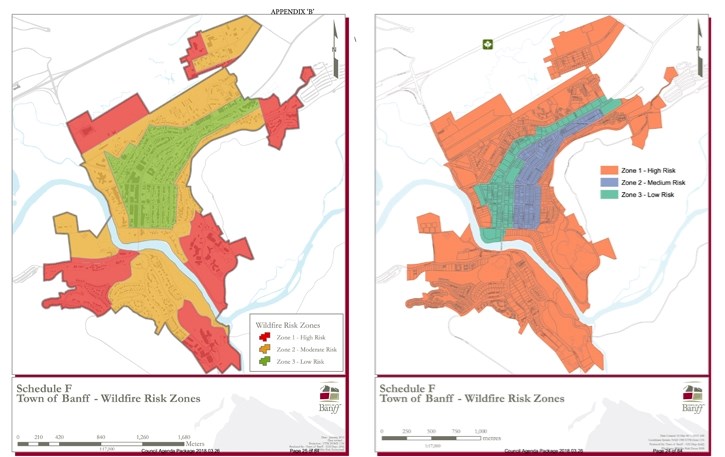Most of the Banff townsite will likely be declared a high-risk zone for wildfire.
Most of the Banff townsite will likely be declared a high-risk zone for wildfire.
At a council meeting Monday (March 26), town council passed first reading of a bylaw to alter the fire risk zone map, which would place most of the town in the high risk zone, including the entire south side of the Bow River and the industrial compound.
A public hearing has been set for April 23 on proposed map changes, which establish fire hazard areas throughout town on a three level scale - high, moderate and low.
Officials say these zones are established to make sure future development and landscaping takes into account the threat of wildfires, noting there could be future changes to the land use bylaw around roofing materials, for example.
"This is about how we can mitigate and adapt our building construction and our landscaping to be better fire resistant in the event of a wildland fire," said Silvio Adamo, Banff's fire chief and manager of protective services.
"This map is used to guide our requirements for landscaping and building materials and construction of new developments and retrofitting. It's important to note there's no differentiation between high and medium risk in the land use bylaw."
Banff residents were on high alert last summer with the Verdant Creek fire burning 18,017 hectares. The fire shut down backcountry areas, closed Highway 93 South, and forced the evacuation of Sunshine Village and historic Kootenay Park Lodge.
The biggest fire threat to Banff comes from the west or southwest, where the forest continues to age and thicken following a century of wildfire suppression before Parks began a prescribed fire program in the 1980s.
The effects of global warming on temperature, precipitation levels and soil moisture are turning many forests into kindling and fires are expected to burn more frequently, with more intensity and become increasingly unpredictable.
Adamo said fires in B.C. and Alberta, including Slave Lake in 2011 and Fort McMurray in 2016, which forced the largest wildfire evacuation in Alberta's history, led many land managers and municipalities to rethink their fire readiness plans.
He said Banff's fire zone map, which first came into effect in 2006, looks at high risk zones in the context of new understanding of fire behaviour based on science and experiences in some of those recent fires.
"Looking at ember loading and travel of embers they learned from Fort McMurray, it just made sense to narrow down that risk," said Adamo.
"As we've seen over the last few years, where we have longer, hotter summers, we're in extreme fire hazard more often, so as far as duration of extreme fire hazard, it just makes sense to narrow that lower risk zone."
The primary change to the map is the conversion of portions of areas previously designated moderate to high, which now includes the entire south side of the Bow River, western portions of the townsite and the industrial area.
The low risk zone essentially runs the length of Banff Avenue, while the moderate zone primarily includes residential neighbourhoods to the immediate east of Banff Avenue.
"These zones are established to ensure that development takes place in a manner that considers wildfire interface risk to person and property," said Randall McKay, the Town's director of planning and development. "They seek to mitigate that risk through design management and recommended planting regimes."
Of the three factors that contribute to wildland fire behaviour - fuel, topography and weather - McKay said fuel could most easily be managed through vegetation management and other mitigation measures.
"The risk to property and life posed by wildland fire can be reduced by addressing it through land use planning, and by using tools available through municipal planning processes," said McKay.
As the Town works through potential amendments to the land use bylaw to look at wildfire mitigation, Adamo said some mitigations may be applied town-wide regardless of the fire risk zone.
"An example of that would be we'll probably push to try to not have any combustible roofs remaining within our community because of the risk as our forest gets denser and temperature and weather patterns change," he said.
Presently, the Town of Banff offers financial incentives to homeowners whose homes are in high and moderate wildfire risk zones and currently have an unrated combustible roof system.
Successful projects qualify for $900 per home as part of the $50,000 program. A duplex is eligible for $900 per half duplex.
Under the existing map, there are approximately 170 combustible roofs in high risk zones and approximately 85 combustible roofs in moderate risk zones. The program is currently fully subscribed.
Adamo said getting rid of combustible roofs is probably one of the top ways to reduce risk.
"You want to consider the surface area and the angles and ridges within a cedar shake roof and I would characterize it as a big catcher's mitt for embers," he said.
"It's probably one of the biggest mitigations you can do as far as reducing risk of wildfire in your zone, other than impingement, from an ember loading perspective."
Councillor Chip Olver said it might be time to relook at the program, and up the amount of money for the program given the proposed extension of high-risk zones in the townsite.
"I'm wondering if it would be appropriate for us to consider increasing the amount of that fund because now there would be more properties that would qualify," she said.
